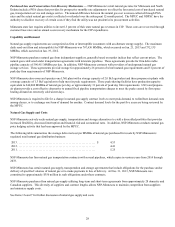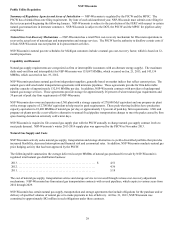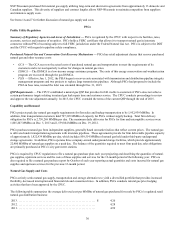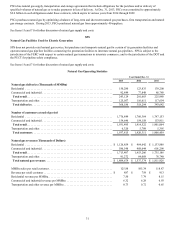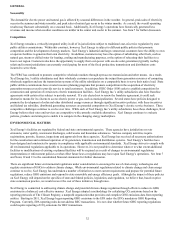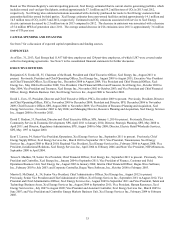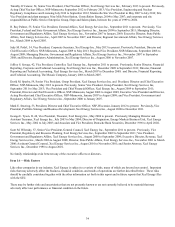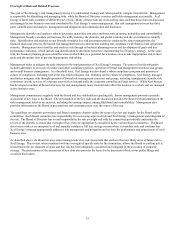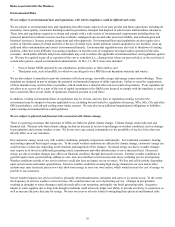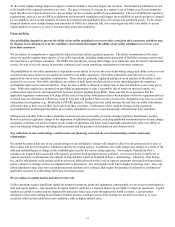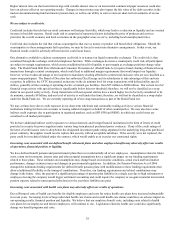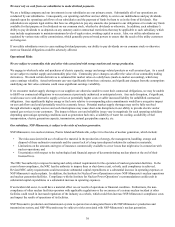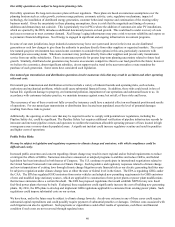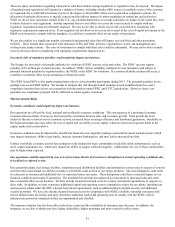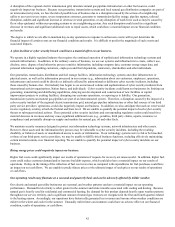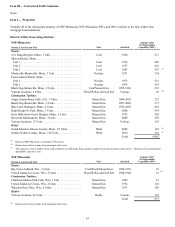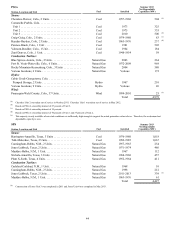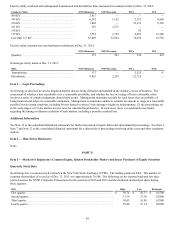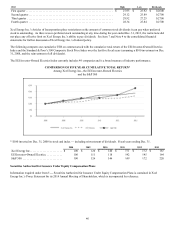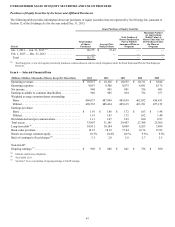Xcel Energy 2013 Annual Report Download - page 55
Download and view the complete annual report
Please find page 55 of the 2013 Xcel Energy annual report below. You can navigate through the pages in the report by either clicking on the pages listed below, or by using the keyword search tool below to find specific information within the annual report.37
To the extent climate change impacts a region’s economic health, it may also impact our revenues. Our financial performance is tied
to the health of the regional economies we serve. The price of energy, as a factor in a region’s cost of living as well as an important
input into the cost of goods and services, has an impact on the economic health of our communities. The cost of additional regulatory
requirements, such as a tax on GHGs or additional environmental regulation could impact the availability of goods and prices charged
by our suppliers which would normally be borne by consumers through higher prices for energy and purchased goods. To the extent
financial markets view climate change and emissions of GHGs as a financial risk, this could negatively affect our ability to access
capital markets or cause us to receive less than ideal terms and conditions.
Financial Risks
Our profitability depends in part on the ability of our utility subsidiaries to recover their costs from their customers and there may
be changes in circumstances or in the regulatory environment that impair the ability of our utility subsidiaries to recover costs
from their customers.
We are subject to comprehensive regulation by federal and state utility regulatory agencies. The utility commissions in the states
where we operate regulate many aspects of our utility operations, including siting and construction of facilities, customer service and
the rates that we can charge customers. The FERC has jurisdiction, among other things, over wholesale rates for electric transmission
service, the sale of electric energy in interstate commerce and certain natural gas transactions in interstate commerce.
The profitability of our utility operations is dependent on our ability to recover the costs of providing energy and utility services to our
customers and earn a return on our capital investment in our utility operations. Our utility subsidiaries provide service at rates
approved by one or more regulatory commissions. These rates are generally regulated and based on an analysis of the utility’s costs
incurred in a test year. Our utility subsidiaries are subject to both future and historical test years depending upon the regulatory
mechanisms approved in each jurisdiction. Thus, the rates a utility is allowed to charge may or may not match its costs at any given
time. While rate regulation is premised on providing an opportunity to earn a reasonable rate of return on invested capital, in a
continued low interest rate environment there has been pressure pushing down ROE. There can also be no assurance that the
applicable regulatory commission will judge all the costs of our utility subsidiaries to have been prudent or that the regulatory process
in which rates are determined will always result in rates that will produce full recovery of such costs. Judgments may arise as a result
of prudence investigations (e.g., Monticello LCM/EPU project). Rising fuel costs could increase the risk that our utility subsidiaries
will not be able to fully recover their fuel costs from their customers. Furthermore, there could be changes in the regulatory
environment that would impair the ability of our utility subsidiaries to recover costs historically collected from their customers.
Management currently believes these prudently incurred costs are recoverable given the existing regulatory mechanisms in place.
However, adverse regulatory rulings or the imposition of additional regulations, including additional environmental or climate change
regulation, could have an adverse impact on our results of operations and hence could materially and adversely affect our ability to
meet our financial obligations, including debt payments and the payment of dividends on our common stock.
Any reductions in our credit ratings could increase our financing costs and the cost of maintaining certain contractual
relationships.
We cannot be assured that any of our current ratings or our subsidiaries’ ratings will remain in effect for any given period of time or
that a rating will not be lowered or withdrawn entirely by a rating agency. In addition, our credit ratings may change as a result of the
differing methodologies or change in the methodologies used by the various rating agencies. For example, Standard & Poor’s
calculates an imputed debt associated with capacity payments from purchased power contracts. An increase in the overall level of
capacity payments would increase the amount of imputed debt, based on Standard & Poor’s methodology. Therefore, Xcel Energy
Inc. and its subsidiaries credit ratings could be adversely affected based on the level of capacity payments associated with purchased
power contracts or changes in how our imputed debt is determined. Any downgrade could lead to higher borrowing costs. Also, our
utility subsidiaries may enter into certain procurement and derivative contracts that require the posting of collateral or settlement of
applicable contracts if credit ratings fall below investment grade.
We are subject to capital market and interest rate risks.
Utility operations require significant capital investment in property, plant and equipment; consequently, we are an active participant in
debt and equity markets. Any disruption in capital markets could have a material impact on our ability to fund our operations. Capital
markets are global in nature and are impacted by numerous issues and events throughout the world economy. Capital market
disruption events and resulting broad financial market distress, could prevent us from issuing new securities or cause us to issue
securities with less than ideal terms and conditions, such as higher interest rates.



